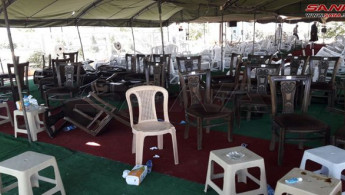Regime and opposition trade blame over attack on 'Syrian Hagia Sophia'
Syrian opposition and regime figures traded accusations over a Sunday attack on a church in Hama, where suicide drones exploded, killing two and injuring 12 attending the church's inauguration day.
The attack, launched on the Hagia Sofia church in a small town in a regime-held territory in northwest Syria, was captured in a dramatic video. A priest's sermon is interrupted by the whine of drones and a series of explosions, causing the congregation to go running.
As of the time of publishing, no party has claimed responsibility for the attack. Both the opposition and the regime accused the other side of being the perpetrator. The use of suicide drones has been recorded by both regime-affiliated and opposition militias in the past.
"The [regime] did the attack so they had an excuse to target Idlib, so that they could tell the world 'See, Idlib targets Christians and civilians,'" Fared al-Mahool, an independent journalist and photographer in Idlib covering the humanitarian crisis in Syria, told The New Arab.
He further pointed to the regime's track record in attacking places of worship within Syria. Between 2011 and 2019, over 60 per cent of the attacks on Christian worship sites within Syria were carried out by the regime, the Syrian Network for Human Rights (SNHR) reported.
Leaders of opposition militias in northwest Syria denied they had anything to do with the attack. Opposition-affiliated media published articles analysing the video of the bombing, claiming to find proof of a staged attack conducted by Iran – Syria's regional ally and military patron.
The analysis echoed the sort typically conducted by pro-regime figures who have sought to prove that videos of chemical attacks on civilians were "staged" or false-flag operations.
Notoriously, large-scale disinformation campaigns by regime supporters have tried to portray the White Helmets, a group of emergency responders, as fabricating attacks and even stealing patients' organs.
"The attack was conducted by the terrorists and mercenaries that work for Turkey. The attack was on all those that support civilisation, humanity, happiness and life," Nabal Abdallah, the commander of the Hama branch of the regime-affiliated National Defense Forces (NDF), told The New Arab. Abdallah was injured during the attack.
The church was built as a replica of the Hagia Sophia in Istanbul, and is a symbol of "Syrian unity," according to Abdallah.
It is also a symbol of the regime's victory over opposition factions which used to control the area, featuring the names of those who died in the town and a statue of a fallen soldier.
"The Turks aim to revive the Ottoman empire. They are against life and tolerance. In this church, there were monuments to martyrs from all religions, sects and from all over Syria. They don't want Syrians to stand together, or to see a Sheikh speaking in the middle of a church," Abdallah said.
The regime has long styled itself as a protector of religious minorities within Syria. By contrast, it has portrayed the opposition as sectarian and hostile to religious minorities, particularly Christians.
It has instrumentalised Christian figures within Syria to galvanise support from the outside. For example, Mother Agnes, a Lebanese nun, has gone on world tours speaking in favour of the Assad regime. A French NGO, SOS Chretiens d'Orient, stands accused of funnelling money to pro-regime militias – money originally donated for humanitarian aid purposes.
The regime has made the reconstruction of religious sites damaged during the war a priority. Engineers from the military – specifically the Military Housing Establishment – were utilized to rebuild the Great Mosque of Aleppo.
At least 124 attacks against Christian places of worship were documented during Syria's civil war, the majority of which were conducted by the regime's forces.
The conflict, which started in 2011 after the Syrian uprising, has continued for more than a decade and has claimed at least 350,000 lives and displaced half the population.





 Follow the Middle East's top stories in English at The New Arab on Google News
Follow the Middle East's top stories in English at The New Arab on Google News


